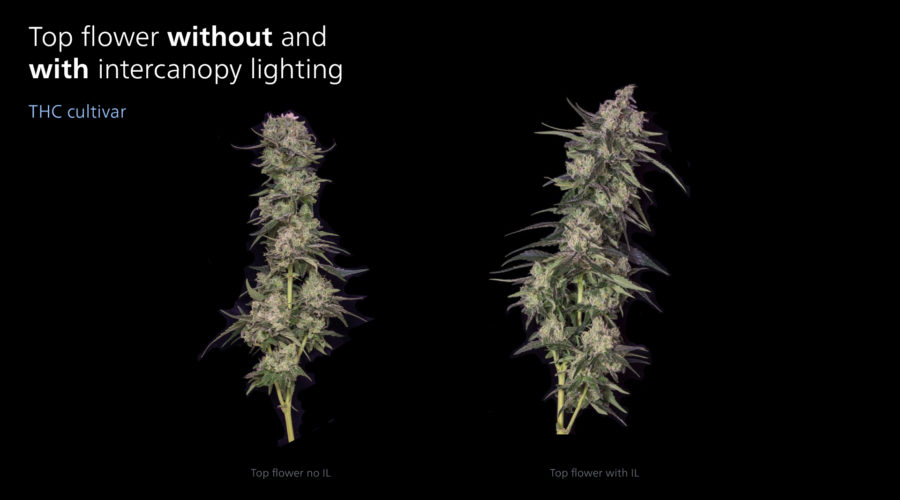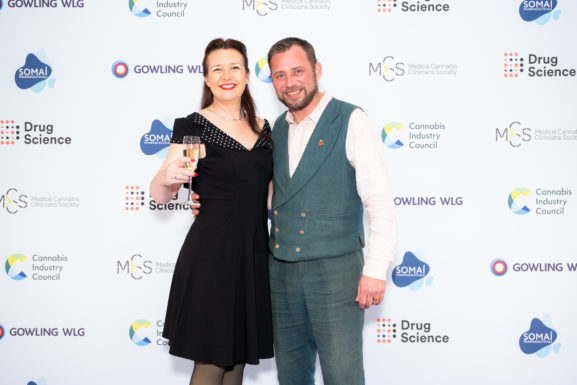How interlighting increases yield in cannabis
By Dr. Céline Nicole-de Groot of CIC member Philips
Additional intercanopy lighting allows more light to penetrate to lower parts of the plant, resulting in large, heavier flowers from top to bottom canopy with a significant upgrade of side flowers. The total yield and the value per m2 also increase significantly with LED intercanopy lighting, meaning more marketable product.
More than five years of research into lighting strategies in cannabis cultivation has provided Philips and its customers with useful knowledge and insights. For example, extreme light levels above the crop (1,500 – 2,000 μmol/m2/s toplighting) result in higher energy costs but do not always produce the expected higher yields. It has recently been re-confirmed that intercanopy lighting (IL) does add value, even at lower light levels. Recent experiments have been achieved in our Cannabis Research Tech Center (CRTC) in the Netherlands. The collaboration with Light4Food and Plagron has brought us new insights into the interaction of intercanopy lights with climate and irrigation. There are several advantages, all of which yield returns.
As the world leader in LED grow light systems for horticultural crops, Philips is at the forefront of applied research into lighting strategies for cannabis cultivation. We do this not only with research partners in the Cannabis Research Tech Center, but one-on-one with other partners and growers.
Despite the high light levels that are common in cannabis cultivation, the plants grow so fast that side shoots are quickly overshadowed by newly formed crop parts. Heavy trimming and de-leafing are usually practiced to allow more light to penetrate from the top to the lower parts of the plant. Despite those actions, our measurements have shown that the lower inflorescence will still encounter a significantly lower light level compared to the top inflorescences. While the upper part of the plants sometimes receives more light than desirable, the lower part could use a bit more light—the entire plant benefits from that. After several crop cycles with different varieties, we determined that IL can achieve an average yield increase of 30%. As a result of the use of efficient IL LED lamps, the increase in biomass per kWh is even higher.
Yield and quality
Extra light between the crops takes photosynthesis in the lower plant parts to a higher level. As a result, more assimilates become available for the lower shoots and later flowers, which makes them develop more strongly. Amazingly, while we expect the lower inflorescences to benefit from the lower intercanopy lights, the top inflorescences had a significant increase in yield compared to a control group. This was repeated systematically in several trials.
Despite differences in the design of these trials (light intensities, spectra, ratio between top lighting and intercanopy lighting), the results are very consistent: additional intercanopy lighting results in heavier, sturdy marketable flowers. Grading becomes more homogeneous and better (more A and B buds) and the share of the least valuable D-grade buds (often waste) is significantly smaller. This is especially important because people pay the most for heavy, high-quality flowers. For many of our customers, “bag appeal” is very important, and sometimes more than yield.
The total yield (grams of flowers per m2) and the value per unit (price per gram) increase significantly with LED intercanopy lighting – exactly what cannabis producers seek. Plant morphological management is essential for the optimal application of IL, and it can vary from variety to variety. Our increased insight into the correct positioning for good light distribution and good plant architecture (lollipopping and defoliation strategy) contributes to more efficient crop management and maximizing yields and quality. We are happy to help cannabis growers get to the next level with high-quality Philips GreenPower LED technology, tailor-made solutions, technical support, and crop knowledge.



